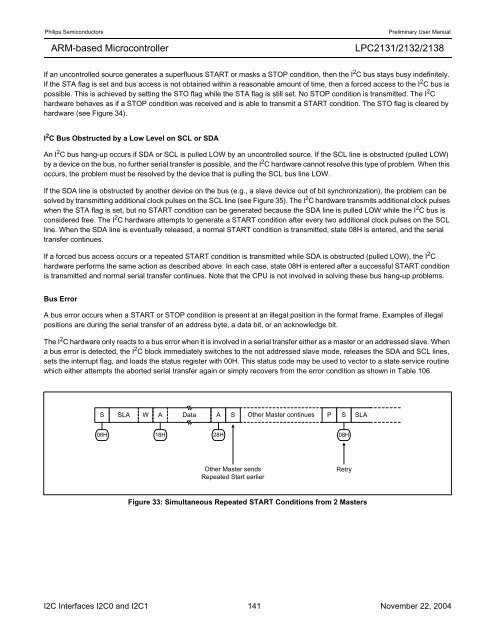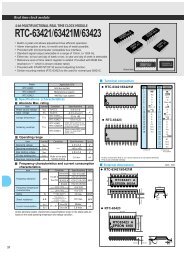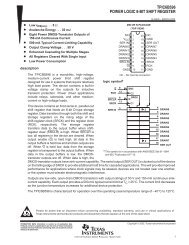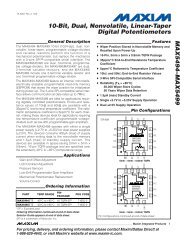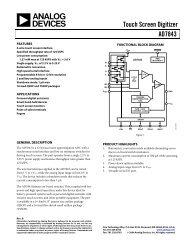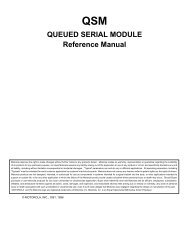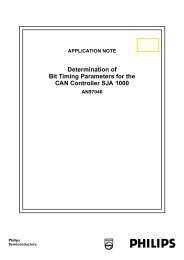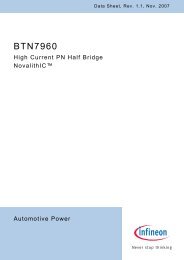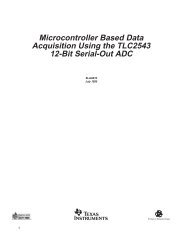You also want an ePaper? Increase the reach of your titles
YUMPU automatically turns print PDFs into web optimized ePapers that Google loves.
Philips Semiconductors Preliminary <strong>User</strong> <strong>Manual</strong><br />
ARM-based Microcontroller<br />
<strong>LPC2131</strong>/<strong>2132</strong>/<strong>2138</strong><br />
If an uncontrolled source generates a superfluous START or masks a STOP condition, then the I 2 C bus stays busy indefinitely.<br />
If the STA flag is set and bus access is not obtained within a reasonable amount of time, then a forced access to the I 2 C bus is<br />
possible. This is achieved by setting the STO flag while the STA flag is still set. No STOP condition is transmitted. The I 2 C<br />
hardware behaves as if a STOP condition was received and is able to transmit a START condition. The STO flag is cleared by<br />
hardware (see Figure 34).<br />
I 2 C Bus Obstructed by a Low Level on SCL or SDA<br />
An I 2 C bus hang-up occurs if SDA or SCL is pulled LOW by an uncontrolled source. If the SCL line is obstructed (pulled LOW)<br />
by a device on the bus, no further serial transfer is possible, and the I 2 C hardware cannot resolve this type of problem. When this<br />
occurs, the problem must be resolved by the device that is pulling the SCL bus line LOW.<br />
If the SDA line is obstructed by another device on the bus (e.g., a slave device out of bit synchronization), the problem can be<br />
solved by transmitting additional clock pulses on the SCL line (see Figure 35). The I 2 C hardware transmits additional clock pulses<br />
when the STA flag is set, but no START condition can be generated because the SDA line is pulled LOW while the I 2 C bus is<br />
considered free. The I 2 C hardware attempts to generate a START condition after every two additional clock pulses on the SCL<br />
line. When the SDA line is eventually released, a normal START condition is transmitted, state 08H is entered, and the serial<br />
transfer continues.<br />
If a forced bus access occurs or a repeated START condition is transmitted while SDA is obstructed (pulled LOW), the I 2 C<br />
hardware performs the same action as described above. In each case, state 08H is entered after a successful START condition<br />
is transmitted and normal serial transfer continues. Note that the CPU is not involved in solving these bus hang-up problems.<br />
Bus Error<br />
A bus error occurs when a START or STOP condition is present at an illegal position in the format frame. Examples of illegal<br />
positions are during the serial transfer of an address byte, a data bit, or an acknowledge bit.<br />
The I 2 C hardware only reacts to a bus error when it is involved in a serial transfer either as a master or an addressed slave. When<br />
a bus error is detected, the I 2 C block immediately switches to the not addressed slave mode, releases the SDA and SCL lines,<br />
sets the interrupt flag, and loads the status register with 00H. This status code may be used to vector to a state service routine<br />
which either attempts the aborted serial transfer again or simply recovers from the error condition as shown in Table 106.<br />
S SLA W A Data A<br />
08H 18H 28H<br />
S Other Master continues P S SLA<br />
Other Master sends<br />
Repeated Start earlier<br />
Figure 33: Simultaneous Repeated START Conditions from 2 Masters<br />
I2C Interfaces I2C0 and I2C1 141 November 22, 2004<br />
08H<br />
Retry


